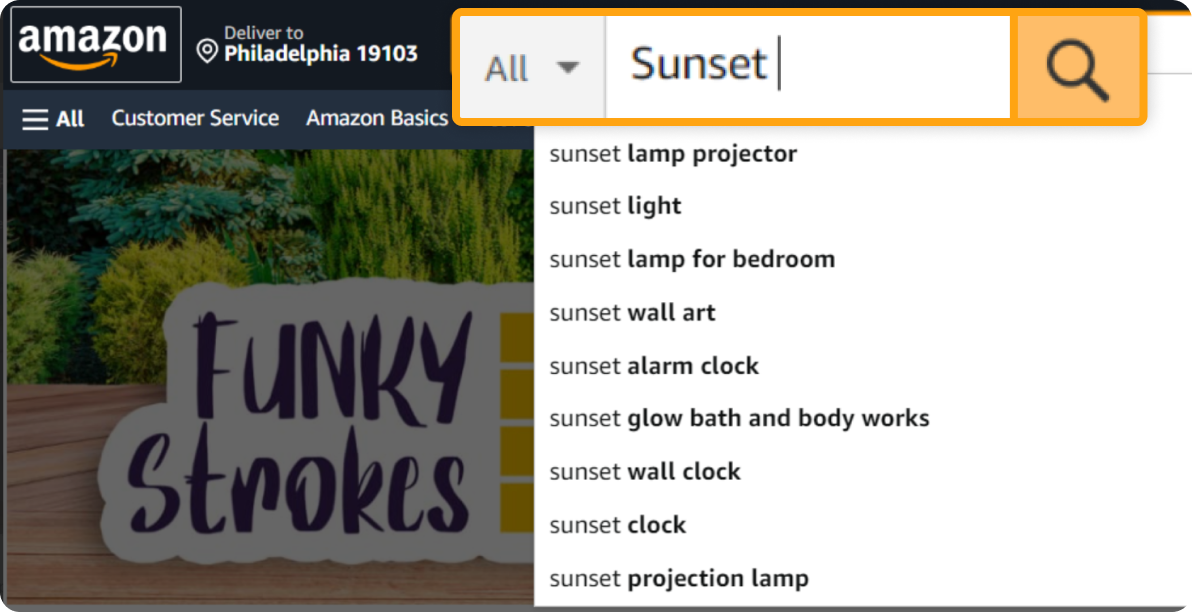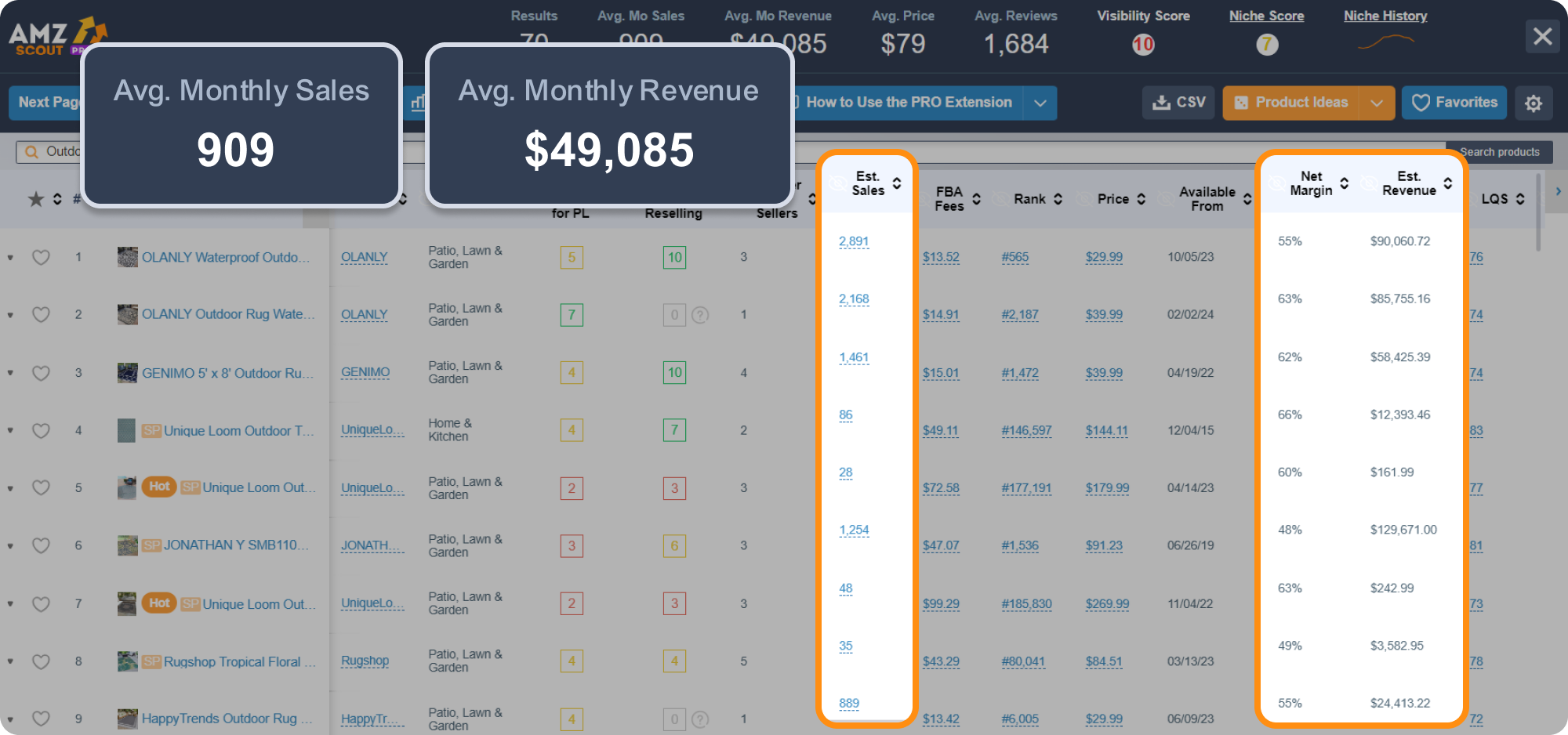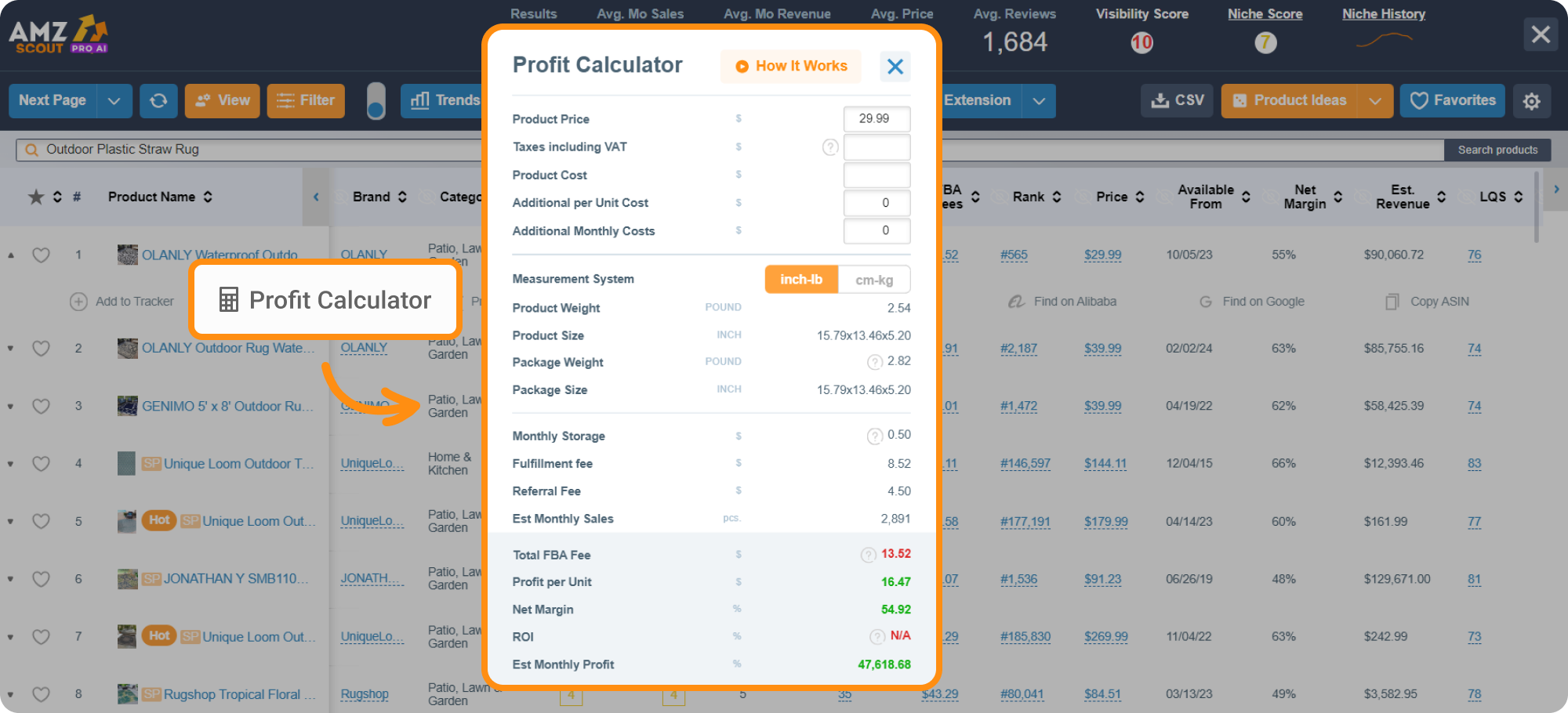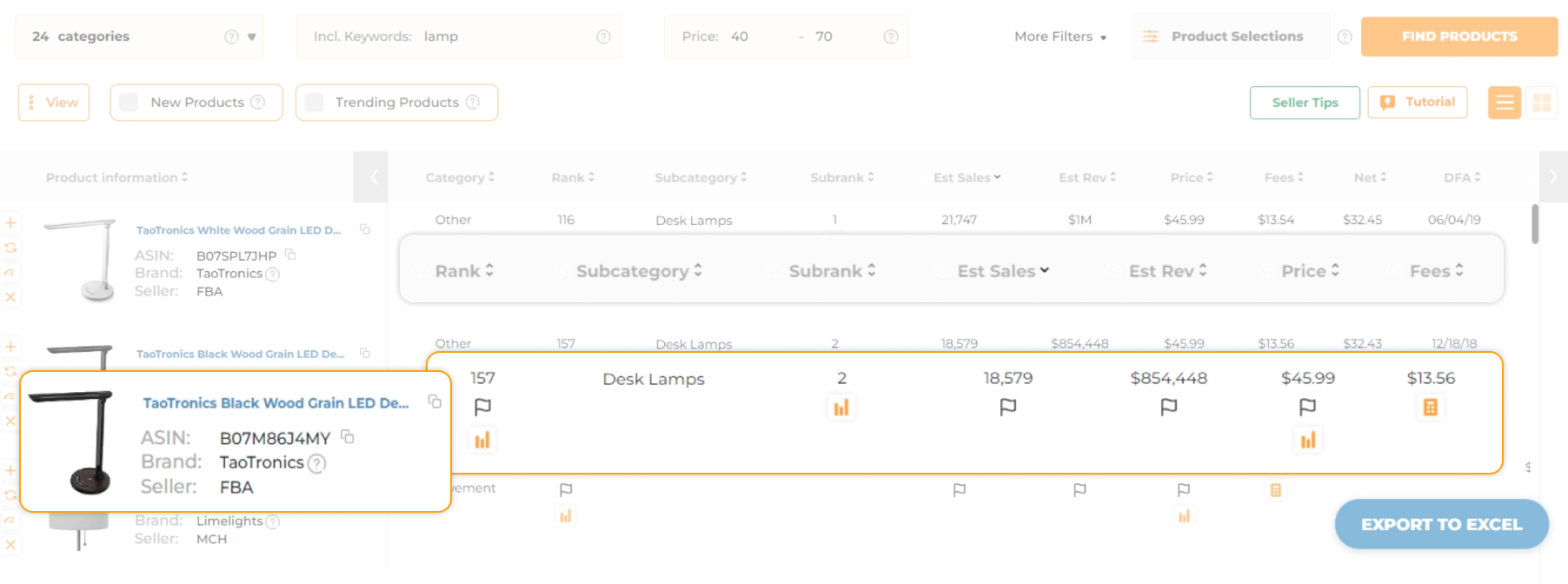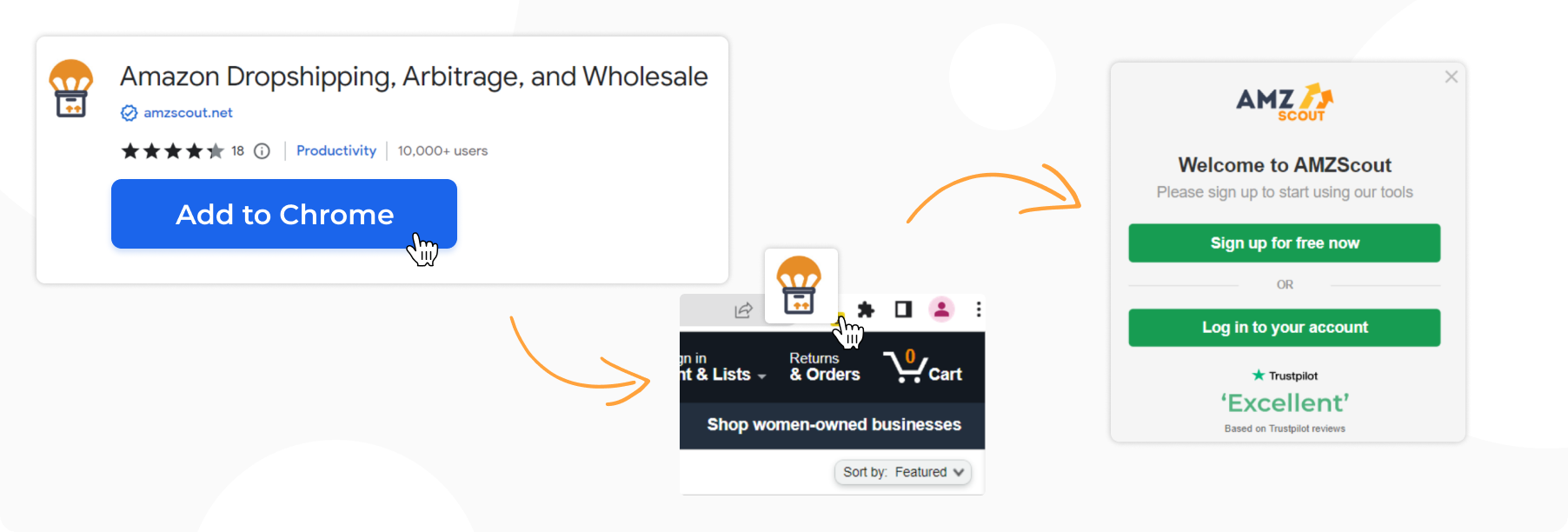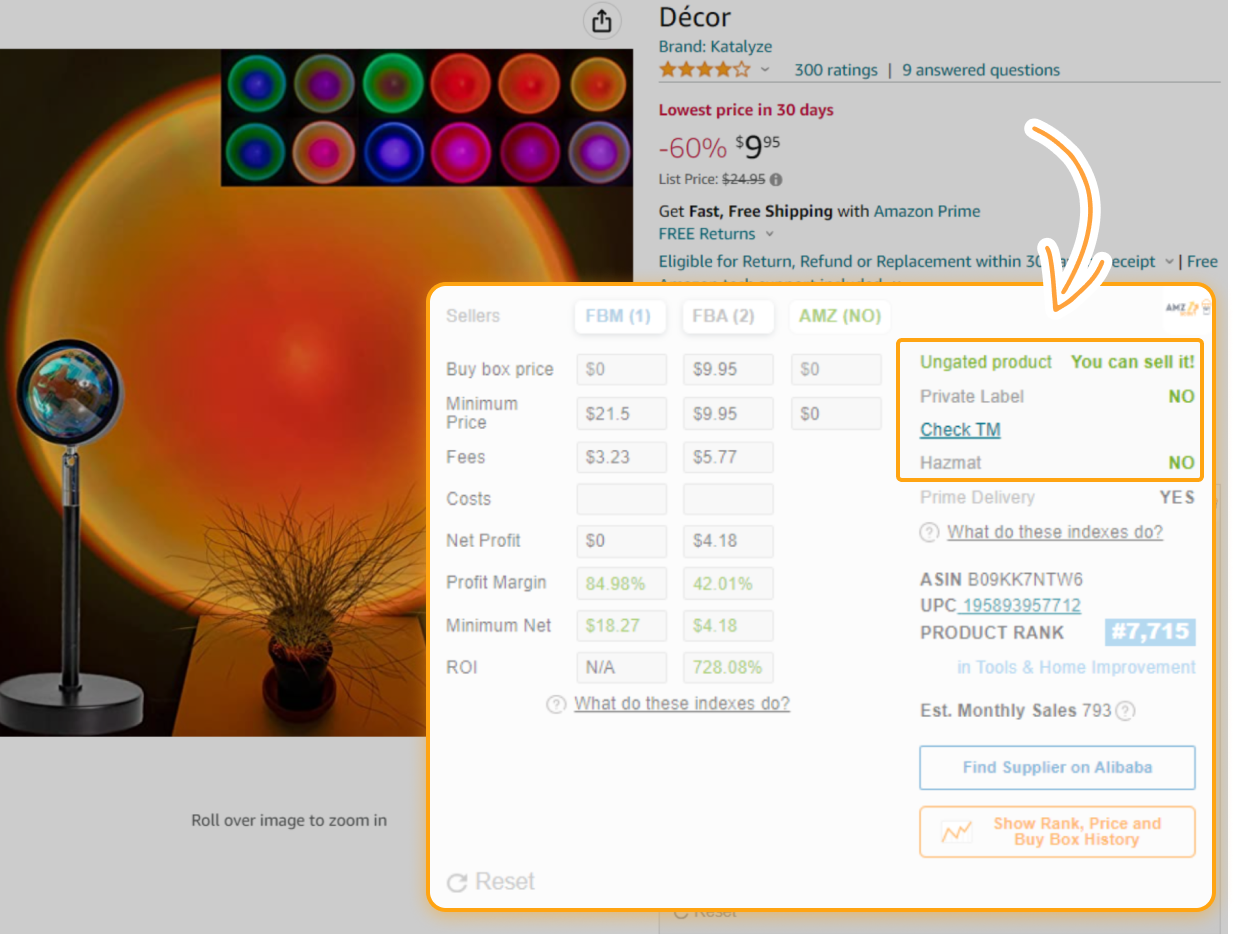
Amazon Analytics Tools for Sales Data Analysis
Whether you're an experienced Amazon seller or just starting out, utilizing Amazon analytics tools is vital to achieve success on the platform. These tools help you analyze tons of data automatically, as they enable you to see sales data for individual items or entire niches and choose a profitable product, boost your sales, spot trends, and analyze competition. From private-label brand owners to resellers, analytics tools can be used by anyone to save you time and effort, and minimize your risks of making mistakes.
In this article, we will discuss a variety of tools that can be helpful for any Amazon seller:
The MZScout PRO AI Extension provides key sales metrics and information about historical fluctuations for any product or niche. This tool enables you to conduct in-depth product research, check Amazon trends, and analyze the competition.
The AMZScout Product Database helps sellers find products based on your desired criteria. You can filter items by sales volume, categories, price, sellers, etc. or look for new or trending products for further analysis.
The Amazon Dropshipping, Arbitrage, and Wholesale Extension is a key sales analytics tool for Amazon resellers. With its help, you can check Buy Box rank and price history, estimate sales, and calculate potential profits and margins.
The Amazon Product Tracker helps monitor daily changes in key sales metrics for selected products.
Sellerhook’s services provide personalized product analytics. If you’re looking for winning products to align with your business model, Sellerhook experts will find the most suitable items for you and your business goals.
AMZScout PRO AI Extension
AMZScout’s PRO AI Extension stands as a robust Chrome extension for Amazon product research and sales data analysis.
This tool can help you analyze the following data:
Niche and product sales data
Sales and price history
Estimated revenue
Competition
Trends
FBA fees
…and tons of other helpful details.
This tool provides you with valuable sales insights about each product, as well as entire niches, while you simply navigate through the marketplace.
The key steps you can take to thoroughly analyze sales of any product are outlined below.
Step 1: Install the PRO AI Extension. Initiate your AMZScout free trial by entering your email address. No credit card details are required.
Step 2: Find a product or a niche you want to analyze. Type anything you want to analyze into Amazon's search bar. For instance, you can enter “women's backpacks”, “KAAI backpack”, or “waterproof women's backpacks” in the search bar or open any product page.
Click on the AMZScout PRO AI Extension icon. Now, you’ll be able to view a plethora of data in the window that appears.
Step 3: Analyze sales data.
Niche sales data. In the upper portion of the screen, you can see Niche Sales data, including Average Monthly Sales, Revenue, and Net Magin.
Product sales data. You can see each piece of Product Sales data on Amazon in a comprehensive table below and check the number of sales and estimated revenue.
Step 4: Estimate your profits with the Profit Calculator. Click Profit calculator, and enter cost data, such as expenses for purchases, delivery, and other additional costs. The calculator will count your Estimated Profit, Net Margins, FBA fees, and other information customized to your particular product.
If you don’t know the cost of the product, you can click Find on Alibaba, which will lead you directly to the product page on the Alibaba website.
Step 5. Check sales and price history.
Click on the Product History to see insights about the product's price, rank, sales, and how these metrics have evolved over time. If these metrics are currently growing or stable, these are good indicators.
Click on the Niche History to study the historical performance of the niche in the market, including price fluctuations and sales numbers.
Step 6: Evaluate the number of sellers. Look at the Number of Sellers column to find out how many merchants offer this product in the listing. The total sales are divided among them. If there are too many other sellers in the listing, this may indicate high competition.
Step 7: Gauge the number of reviews. This is an indirect indicator of sales: the higher this figure is, the more sales there are. However, at the same time, a high number of reviews can also be a sign of high competition.
If you want to conduct an analysis to find a product with particular metrics, such as a specific sales volume, number of sellers, and so on, it's easier to start with the Product Database. Below, find out more about how you can use this tool.
AMZScout Product Database
Product research tools like the AMZScout Product Database can help you identify popular and advantageous Amazon product ideas.
It allows you to set specific search criteria, and you'll see a clear table of items that meet them.
The Product Database has the following filters for product analysis:
Estimated sales and revenue
Price history
First available date
The number of sellers
Number of reviews
…and more
Below, we'll illustrate how you can employ the AMZScout Product Database to discover profitable products on Amazon.
Step 1: Go to the AMZScout Product Database.
Step 2: Log into your account or start your free trial. The signup process only requires entering an email address – no credit card details are required.
Step 3: Use the search filters to define your product preferences.
Categories - Pick from any of the 24 categories or you can enter a related keyword to narrow down your search.
Estimated Sales - Set how many sales a product should have (for example, more than 300).
Reviews - Set the number of reviews you prefer (for example, less than 100).
Price - Select a price range that matches your preferences.
Number of sellers - Enter a minimum, maximum, or both numbers of sellers in the listing.
First available date - If you want to find products that started selling recently or within a specific timeframe, choose the date when a product became available.
If you're unsure about how to set your filters, you can click on the Product Selections button and choose one of the presets based on your goal, such as Get TOP-1,000 best-selling products in any category.
Step 4: Choose new and trending products.
If you want to find products that were added recently, or those whose sales have grown by 20% in the last three months, you can customize your table view. To choose these products, place corresponding checkmarks in front of New and Trending.
Step 5: Analyze the search results table. Click Find Products to get your results. Evaluate any items’ sales, product prices, estimated revenue, reviews, price history, and fees.
Diving into thorough Amazon analytics for sellers with the help of AMZScout’s Product Database will help you spot product ideas and estimate their performance in a glance.
If you want to analyze sales of products that are suitable for the dropshipping, wholesale, or online arbitrage business models, you can make use of the next tool, which is the Amazon Dropshipping, Arbitrage, and Wholesale Extension.
Amazon Dropshipping, Arbitrage, and Wholesale Extension
Dropshipping, arbitrage, and wholesale business models have gained popularity due to their low barriers to entry and high potential for profitability in both online and retail markets. To analyze products eligible for resale easily and see their sales data, use the Amazon Dropshipping, Arbitrage, and Wholesale Extension.
Step 1: Install the Amazon Dropshipping, Arbitrage, and Wholesale Extension.
Step 2: Access key sales insights for each product through Amazon’s search page. See crucial information right on the Search Page, displayed beneath each product. You'll find details like:
Est. Monthly Sales
Margin
BSR
Number of Sellers
Type of Seller (FBA, FBM, or Amazon)
First Available Date
…and more.
These insights are helpful in analyzing overall product performance.
Step 3: Perform a deeper analysis of each product’s sales. Go even further by analyzing your chosen product on the Product Page. Here, you'll encounter comprehensive information, including:
Buy Box Owner history
Buy box price and minimum price history
BSR and its historical data
Sales restrictions (like Gated categories, Hazardous Material, Trademark, etc.)
Number of sellers categorized as FBA, FBM, or Amazon
…and numerous additional details.
Step 4: Estimate profits with the Profit Calculator. The calculator appears directly on the product page. There, you can see FBA fees and input cost data, including purchase, delivery, as well as other additional expenses. The calculator will show you the Net Profit, Profit Margin, Minimum Net, and ROI tailored to your specific product.
If you're unsure about the product’s cost, you can click the Find Supplier on Alibaba button and get that information right away.
Amazon Product Tracker
Another smart analyzer is the Product Tracker, which can help you keep a watchful eye on chosen product ideas, all in a dynamic manner.
Key monitored data includes daily shifts for these metrics:
Sales
Ratings
Inventory levels
Review count
This valuable information assists sellers in conducting a precise analysis of any product.
Outsource Sales Data Analysis to Sellerhook Experts
Analyzing a multitude of figures to get the overall picture of product sales can be challenging, even for an experienced analyst. If you're going through this process to help you determine which products to sell, there are even more factors to consider, such as competition, profitability, and so on. Therefore, it might be easier to entrust these tasks to professionals like Sellerhook.
With this option, you have the opportunity to use services provided by a team of experts who are dedicated to helping you tackle this challenge. They do all of the hard work for you by analyzing tons of data with the help of AI, and carefully identifying products that align with your specific requirements. Your role is simple: answer a brief questionnaire, and wait 10 business days to receive a report with products that perfectly match your unique criteria.
All you need to share for Sellerhook’s team to choose the right product ideas for you is the following:
Your business model type
Preferred product category
Desired price range
Which criteria are most important to you (for example: high revenue, low competition, product size, novelty of the niche, stable demand, or the opportunity to attract returning customers)
Whether you would consider selling oversized products
Your personal preferences for the product
Your country of citizenship (so analysts can find suitable suppliers for you)
Email address
That's all! The experts at Sellerhook will examine a wealth of data, including ROI, demand, margins, keywords, and perform detailed reporting on why these products were specifically chosen for you.

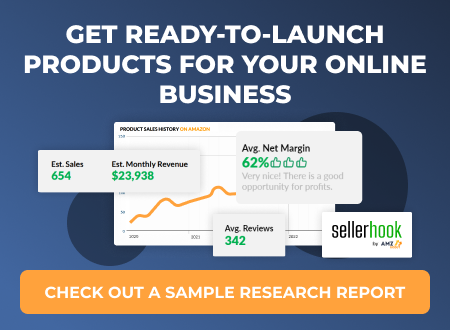
Conclusion
In order to effectively analyze Amazon sales and track all of the necessary data you need to make the most informed decisions, relying solely on the Seller Central interface is not enough. Whether you're a new or an experienced seller, sales analytics software like AMZScout’s PRO Extension, Product Database, Amazon Product Tracker, and services like Sellerhook offer all of the features you need for automation, spotting best seller ideas, and performance data analysis.
These Amazon product analytics tools can empower you to navigate the marketplace confidently and gain potential for success with your store.


